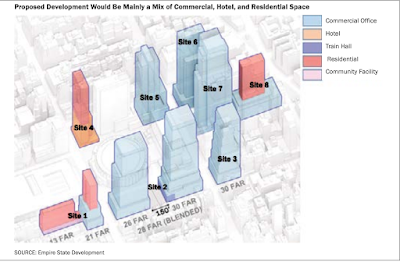New York State officials on Thursday approved a sweeping redevelopment of Midtown Manhattan that would transform Pennsylvania Station, the busiest transportation hub in North America, from a run-down transit center into a city centerpiece. The eight-member board of Empire State Development, the state’s economic development agency and the group steering the project, unanimously voted in favor. The plan calls for constructing 10 towers around Penn Station and providing an estimated $1.2 billion in tax breaks to developers. The redevelopment would be among the largest real estate projects in United States history: roughly 18 million square feet of mostly office space, up to 1,800 residential units, retail space and a hotel. At the center would be a renovated Penn Station, which sits below Madison Square Garden and served 650,000 riders each weekday before the pandemic. The board’s approval clears the way for an application for federal funding to help pay for upgrading the station, which is expected to cost about $7 billion. New York expects about half of that sum to come from Washington...
The new towers would be among the tallest in New York City, exceeding 1,000 feet in height, though the final dimensions would be decided later. The project requires the demolition of many existing buildings, potentially including a 150-year-old Roman Catholic church, and would reshape the skyline of Manhattan between the Hudson Yards neighborhood to the west and the Empire State Building to the east... The M.T.A. is leading the $7 billion renovation project at the station but New York expects the federal government, Amtrak and New Jersey to contribute most of the money. An agreement the state reached with New York City allows for payments from developers of the 10 towers to cover part of station renovation costs, all of the costs of the pedestrian and street improvements and half of the costs of the new subway entrances and underground concourses. The payments from the developers would derive from office leases, retail sales, apartment rentals and the hotel. That arrangement is part of a complex financial scheme known as payments in lieu of taxes, or PILOTs, that would suspend additional property taxes on the buildings for decades after they are constructed.
I had blogged here that the biggest problem with the railway stations redevelopment projects in India is that they are conceived and planned as predominantly railway station redevelopment projects instead of being seen as urban renewal projects. The fact that these projects are led by Railway Department and its officials with limited understanding of urban planning, and have limited engagement with and stakes of the local city administrations (beyond the perfunctory memberships in some committees) speaks volumes about its flawed design.
If these projects are to realise their true potential, the entire redevelopment should be undertaken under the leadership of the local government as a generational project with the objective of transforming the economic prospects of the area around the station. It will have to be preceded by extensive local consultations and public debates, economic growth planning and infrastructure and real estate needs assessment, all of which have to be led by the local government. In fact, the least important stakeholder in the redevelopment would be the Railways Department.
This is also a teachable example of the problems with experts-driven policy making in complex public issues like urban renewal. An expert like E Sreedharan can be great at a driving pure infrastructure development project but is unlikely to be successful with a civic project.
On similar lines, as I have blogged here, India's urban metro railways projects are generational opportunities to shape the destiny of cities which too have been lost or frittered away for lack of integration with urban planning. Like the railway stations redevelopment, these too have been seen as primarily infrastructure development projects. Even within the Ministry of Housing and Urban Affairs, these projects are driven by Railways Department officials. These have to change.


No comments:
Post a Comment